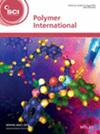求助PDF
{"title":"Catalyst-free synthesis, characterization and photoluminescence of main-chain luminescent polybenzoxazines","authors":"Kamal I Aly, Aya Khamies, Osama Younis","doi":"10.1002/pi.6753","DOIUrl":null,"url":null,"abstract":"<p>Two novel luminescent main-chain polybenzoxazine polymers, (Poly1)<sub>main</sub> and (Poly2)<sup>x</sup><sub>main</sub>, were synthesized and characterized to explore their structural, thermal, morphological and photophysical properties. Polymer (Poly1)<sub>main</sub> was obtained via a Mannich condensation reaction without a catalyst, followed by thermal polymerization to produce the crosslinked polymer (Poly2)<sup>x</sup><sub>main</sub>. Structural analyses using Fourier transform infrared spectroscopy and X-ray diffraction confirmed the successful formation of the polymers, with (Poly2)<sup>x</sup><sub>main</sub> exhibiting a higher degree of crosslinking and partial ordering in an otherwise amorphous structure. Scanning electron microscopy imaging revealed that thermal polymerization significantly altered the morphology, transforming the porous structure of (Poly1)<sub>main</sub> into a denser, layered morphology in (Poly2)<sup>x</sup><sub>main</sub>. Thermogravimetric analysis and differential scanning calorimetry highlighted the improved thermal stability of (Poly2)<sup>x</sup><sub>main</sub> due to extensive crosslinking. Photophysical studies showed that (Poly1)<sub>main</sub> in solution exhibited yellow-green luminescence with a broad emission maximum at 522 nm and CIE coordinates (0.39, 0.48). In contrast, the powders of both polymers displayed sharp red luminescence with an emission peak at 658 nm and CIE coordinates (0.72, 0.27), attributed to molecular packing effects and exciton coupling in the solid state. These results underscore the interplay among structural, morphological and photophysical properties, highlighting the potential of these polymers in optoelectronics, sensing and luminescent materials. © 2025 Society of Chemical Industry.</p>","PeriodicalId":20404,"journal":{"name":"Polymer International","volume":"74 7","pages":"602-610"},"PeriodicalIF":3.6000,"publicationDate":"2025-03-03","publicationTypes":"Journal Article","fieldsOfStudy":null,"isOpenAccess":false,"openAccessPdf":"","citationCount":"0","resultStr":null,"platform":"Semanticscholar","paperid":null,"PeriodicalName":"Polymer International","FirstCategoryId":"92","ListUrlMain":"https://scijournals.onlinelibrary.wiley.com/doi/10.1002/pi.6753","RegionNum":4,"RegionCategory":"化学","ArticlePicture":[],"TitleCN":null,"AbstractTextCN":null,"PMCID":null,"EPubDate":"","PubModel":"","JCR":"Q2","JCRName":"POLYMER SCIENCE","Score":null,"Total":0}
引用次数: 0
引用
批量引用
Abstract
Two novel luminescent main-chain polybenzoxazine polymers, (Poly1)main and (Poly2)x main , were synthesized and characterized to explore their structural, thermal, morphological and photophysical properties. Polymer (Poly1)main was obtained via a Mannich condensation reaction without a catalyst, followed by thermal polymerization to produce the crosslinked polymer (Poly2)x main . Structural analyses using Fourier transform infrared spectroscopy and X-ray diffraction confirmed the successful formation of the polymers, with (Poly2)x main exhibiting a higher degree of crosslinking and partial ordering in an otherwise amorphous structure. Scanning electron microscopy imaging revealed that thermal polymerization significantly altered the morphology, transforming the porous structure of (Poly1)main into a denser, layered morphology in (Poly2)x main . Thermogravimetric analysis and differential scanning calorimetry highlighted the improved thermal stability of (Poly2)x main due to extensive crosslinking. Photophysical studies showed that (Poly1)main in solution exhibited yellow-green luminescence with a broad emission maximum at 522 nm and CIE coordinates (0.39, 0.48). In contrast, the powders of both polymers displayed sharp red luminescence with an emission peak at 658 nm and CIE coordinates (0.72, 0.27), attributed to molecular packing effects and exciton coupling in the solid state. These results underscore the interplay among structural, morphological and photophysical properties, highlighting the potential of these polymers in optoelectronics, sensing and luminescent materials. © 2025 Society of Chemical Industry.
主链发光聚苯并恶嗪的无催化剂合成、表征及光致发光
合成了两种新型发光主链聚苯并恶嗪聚合物(Poly1)main和(Poly2)xmain,并对其结构、热学、形态和光物理性能进行了表征。采用曼尼希缩合反应制得聚合物(Poly1)main,无催化剂,热聚合制得交联聚合物(Poly2)xmain。使用傅里叶变换红外光谱和x射线衍射的结构分析证实了聚合物的成功形成,(Poly2)xmain在非晶态结构中表现出更高程度的交联和部分有序。扫描电镜成像显示,热聚合显著改变了(Poly1)main的形貌,将(Poly2)xmain的多孔结构转变为致密的层状结构。热重分析和差示扫描量热法强调,由于广泛的交联,(Poly2)xmain的热稳定性得到了改善。光物理研究表明,(Poly1)主溶液在522 nm和CIE坐标(0.39,0.48)处具有宽发射最大值的黄绿色发光。相比之下,两种聚合物的粉末都显示出明显的红色发光,发射峰位于658 nm, CIE坐标为(0.72,0.27),这是由于分子堆积效应和固体状态下的激子耦合。这些结果强调了结构、形态和光物理性质之间的相互作用,突出了这些聚合物在光电子、传感和发光材料中的潜力。©2025化学工业协会。
本文章由计算机程序翻译,如有差异,请以英文原文为准。




 求助内容:
求助内容: 应助结果提醒方式:
应助结果提醒方式:


